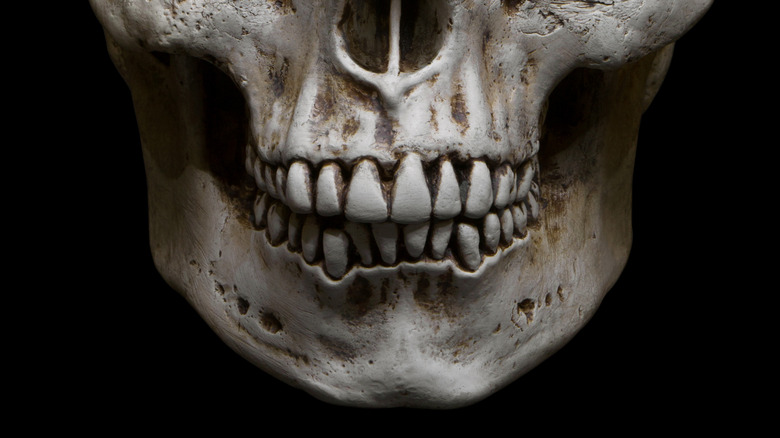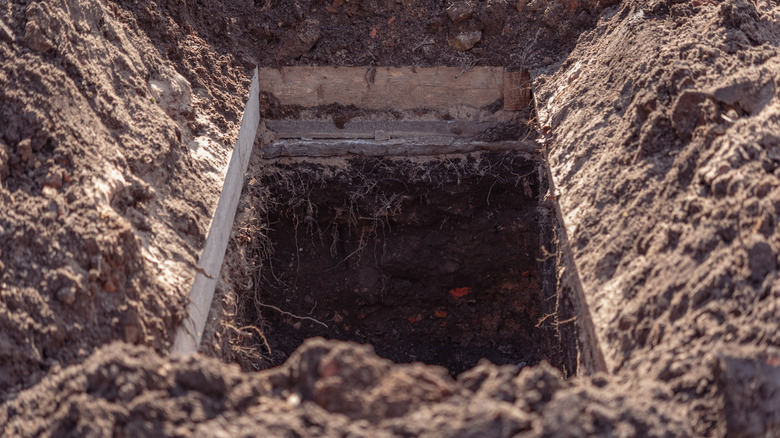Why Jaws Are Wired Shut After Death
The following article contains disturbing details of the embalming process.
Even though death is a natural part of life, not many of us look forward to it. Funerals can be heartbreaking experiences, and wakes can be eerie and surreal if the deceased is on display inside an open casket. The human body decays after death, and rapidly. The most dramatic decay happens within the first month after death. Cells throughout the body die, rigor mortis sets in, then the body bloats from gases, changes colors, and foam and other fluids ooze from orifices. After that the body begins its slow disintegration towards skeletonization over the course of years, even decades. It's all rather gruesome and a firm reminder of why it's so critical to make the most out of life. Morticians and funeral directors help plan funerals and wakes, but it's embalmers who have the grisly responsibility of physically handling and preparing a body for viewing and burial.
Embalming isn't exactly a new practice. The ancient Egyptians were so good at embalming that the mummies of their dead exist all the way to the present. Smithsonian says that they took 70 days to remove a body's organs, keep the body dry, wrap the body in linen, and so forth. In the modern day embalming follows a different, but equally strict procedure. As Everplans explains, bodies are washed, their fluids drained, and jaws sewn or wired shut. Embalmers do this to prevent the mouth from opening, as mouths naturally open when muscles are relaxed.
Keeping the jaw closed
Taking care of a jaw after death involves some disturbing details, so sensitive readers are advised to proceed with caution. In short, jaws are sewn or wired shut as part of an entire facial setting process. As Funeral Guide explains, the goal is to manipulate facial features to resemble as natural of an expression as possible. To that end the eyes are closed, and the embalmer uses glue or oval-shaped "eye caps" to keep the eyes shut, as Everplans says. Hair is combed and set, and faces are shaved unless a person wore a beard while alive.
Jaws require a complicated procedure to keep them closed and to keep the deceased's features intact. If a jaw is sewn shut, embalmers pass thread through the lower gums in the front of the mouth below the front, bottom teeth and up to the upper gums above the front, top teeth. They then pass the thread from the upper gums into one nostril, then through the septum — the cartilage separating the nostrils — into the other nostril and back down into the mouth. Then an embalmer can tighten the thread and tie it off. To close a mouth by wire, an embalmer uses a device called a needle injector that drives a tack into the upper and lower jaws, as an experienced embalmer on The Guardian says. The tacks connect to wires that the embalmer ties together, and then the embalmer rotates the tacks to close the jaw.
Care for the dead
Those who've visited loved ones at wakes can attest to the hard work that embalmers go through in order to make the deceased appear as natural as possible. This includes the set of the features, hair, makeup, and clothing. Many people are disturbed at viewing a corpse — especially a loved one — but with the right attention to care Funeral Guide says that attendees often express surprise at how "well" a loved one looks. Nonetheless, it's important to note that it's impossible for the deceased to look exactly like they did when alive.
On that note, if someone has an accident before death that has damaged or even destroyed their face, that individual can undergo post-mortem surgery to reconstruct it. As Funeral Guide explains, this isn't surgery in the usual sense and is much less straightforward and standard of a process than by-the-numbers embalming or jaw setting. "Master embalmers" Martin Jeffery and Ross Corney in Edinburgh, Scotland head up courses aimed at teaching embalmers the skill of post-mortem surgery. They work for William Purves Funeral Directors, whose chairman Tim Purves said of post-mortem surgery, "We don't go by photos of the person, they won't look exactly as they did in life. It's effectively like a jigsaw." The comfort, he said, comes from loved ones knowing that the deceased received as much attention and care as possible: "Wouldn't you want to know that a loved one had had that time spent on them, rather than the coffin lid closed, because they are in a bad way?" For those who want an open-casket viewing this is doubtlessly foremost on the mind.


